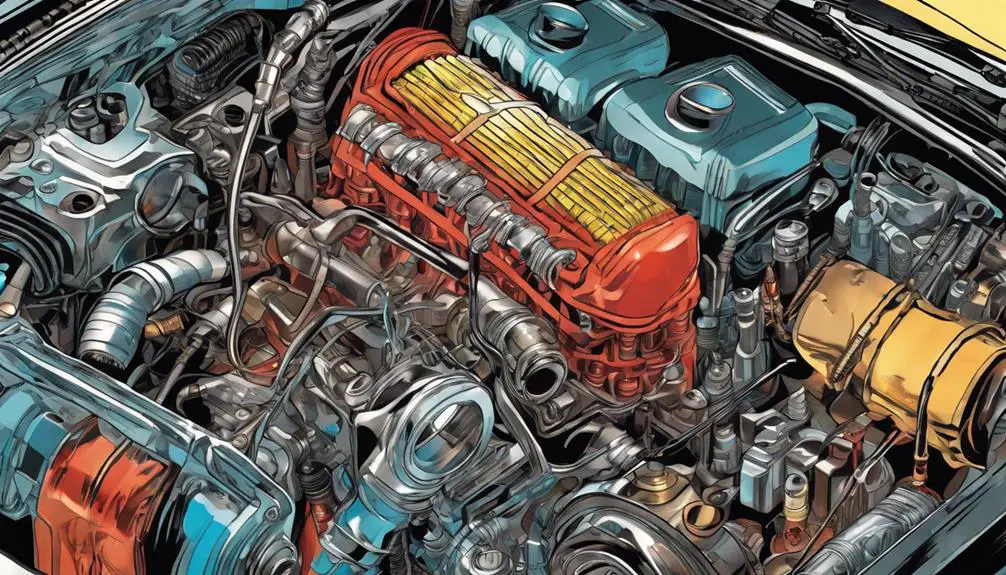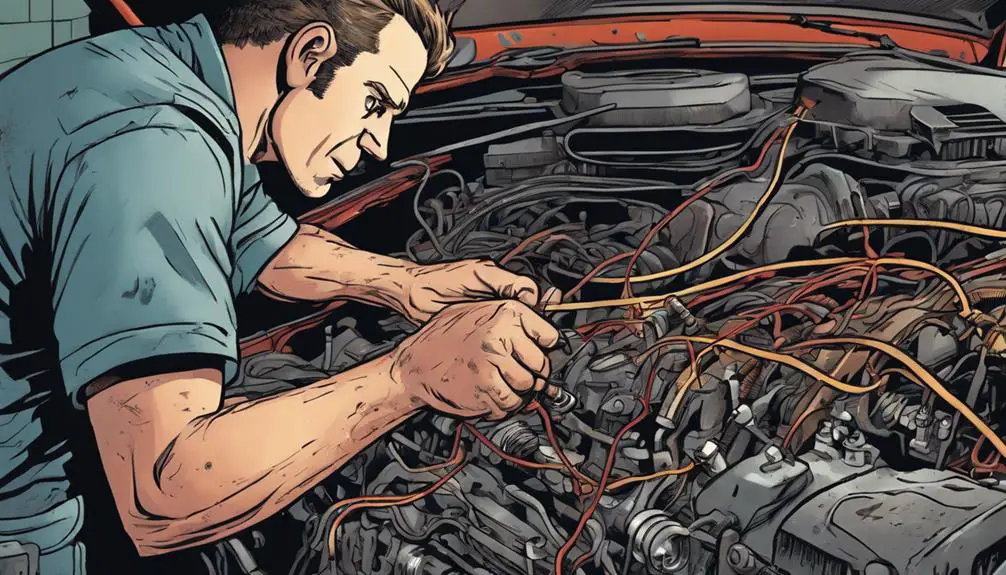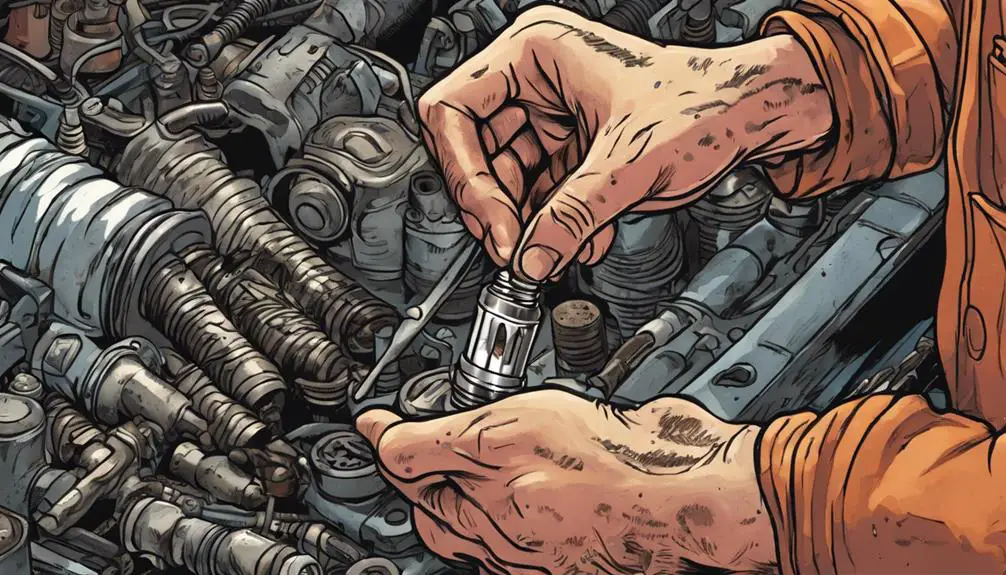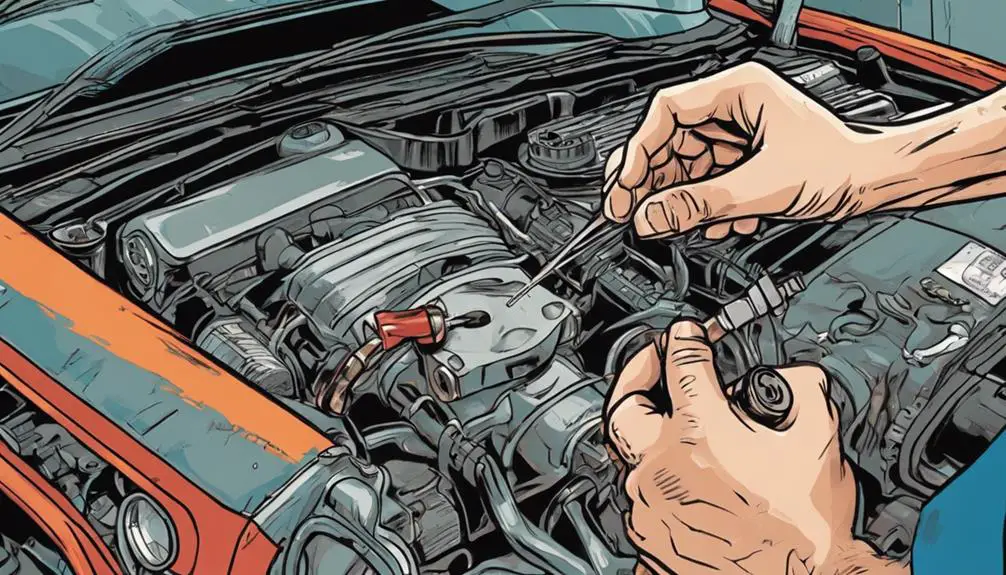Imagine driving down the road when your engine suddenly sputters like a candle flickering in the wind. It's a frustrating experience that can leave you stranded and wondering what went wrong. To tackle engine stalling, you'll want to assess everything from fuel quality to spark plug condition. Each component plays a critical role, and neglecting one could be the difference between smooth rides and unexpected stops. So, what's the first step you should take to get your engine back on track?
Key Takeaways
- Inspect and replace spark plugs if worn or fouled to ensure proper combustion and engine performance.
- Check and clean the air filter to maintain optimal airflow; replace if severely clogged.
- Use high-quality fuel and regularly inspect the fuel system for contaminants or clogs.
- Tighten battery connections and inspect wiring for damage to ensure stable electrical flow.
Understand Engine Stalling Causes

To tackle engine stalling effectively, you first need to understand what causes it in the first place. Engine stalling often arises from issues related to the air-fuel mixture, ignition system, or mechanical components. If your engine's not getting the right amount of fuel or air, it can lead to stalling. Similarly, a faulty ignition system, like worn spark plugs or a malfunctioning coil, can prevent your engine from running smoothly.
You should also consider the condition of the engine itself. Dirty air filters can restrict airflow, while vacuum leaks can disrupt the balance needed for peak performance. Pay attention to any odd sounds or warning lights; they're your engine's way of communicating its distress.
Understanding these causes isn't just about fixing a problem—it's about liberating yourself from the anxiety of unexpected stalls. When you know what's going on under the hood, you empower yourself to take action, whether that means performing maintenance or seeking professional help.
Check Fuel Quality
Checking your fuel quality can make a significant difference in preventing engine stalling. You deserve to drive freely and confidently, so make certain you're using clean, high-quality fuel. Contaminated or old fuel can lead to engine problems, including stalling.
Start by checking your fuel type; verify it meets your vehicle's specifications. If you're using lower-grade fuel, it might contain impurities that can clog your fuel system.
Next, consider the age of your fuel. Gasoline can degrade over time, especially if it's sitting in your tank for months. If you suspect your fuel is stale, it's time to drain the tank and refill it with fresh fuel.
Don't hesitate to check for signs of water or dirt in the tank; these contaminants can cause serious issues.
You can also think about adding fuel additives designed to clean your fuel system and improve combustion. It's a small step that can lead to a smoother driving experience.
Inspect Electrical Connections

When your engine stalls, it's essential to inspect the electrical connections.
Start by checking the battery terminals for corrosion or loose connections.
Then examine the wiring harness for any signs of damage.
Check Battery Terminals
Inspect your battery terminals for corrosion or loose connections, as these issues can disrupt electrical flow and lead to engine stalling. Start by ensuring the engine is off and the keys are out of the ignition. Grab a wrench to check the tightness of the terminal connections. If they're loose, simply tighten them up.
Next, look for any white, chalky residue around the terminals. This corrosion can block the current and hinder your vehicle's performance. To clean it, mix baking soda with water and apply it to the affected areas using a toothbrush. Rinse thoroughly with water and dry it off.
Once you've cleaned and tightened the terminals, consider applying a thin layer of petroleum jelly to prevent future corrosion. Regularly inspecting your battery terminals is a simple yet essential act of car care that empowers you to keep your engine running smoothly.
Examine Wiring Harness
After ensuring your battery terminals are clean and tight, turn your attention to the wiring harness, as damaged or loose electrical connections can also cause engine stalling.
Start by visually inspecting the wiring for any signs of wear, fraying, or corrosion. If you notice any damage, it's essential to address it immediately, as these issues can lead to a loss of power or erratic engine behavior.
Next, check the connectors. Make sure they're securely fastened and free of dirt or grime. You might find that simply unplugging and re-plugging them can improve the connection.
Don't hesitate to use electrical contact cleaner to remove any buildup.
Don't overlook the ground connections either; they play an important role in your engine's electrical system. A poor ground can lead to all sorts of performance issues.
If you find any loose wires or connections, tighten them up.
Test Ground Connections
Check your ground connections, as poor grounding can lead to engine stalling and erratic performance. A solid ground connection is essential for your engine's electrical systems to function correctly. Start by visually inspecting the ground wires for any signs of corrosion or damage. If you find any issues, it's time to clean or replace those connections.
Next, verify that all bolts and connections are tight. Loose connections can disrupt the flow of electricity, leading to unpredictable engine behavior. Remember, a secure connection can liberate your vehicle from unnecessary frustrations.
Here are some key points to reflect on:
- Feel the Freedom: A well-grounded engine runs smoothly, allowing you to enjoy the open road.
- Say Goodbye to Frustration: No more unexpected stalls when you're just trying to get to your destination.
- Embrace Confidence: Trust your vehicle to perform reliably every time you start it up.
Examine Air Filter
A clogged air filter can restrict airflow to the engine, leading to stalling issues. If you want to liberate your vehicle from these frustrating problems, start by checking the air filter. It's a simple yet effective first step in reclaiming your car's performance.
Open the air filter housing and take a good look at the filter. If it's dirty or covered in debris, it's time for a replacement. An air filter that's choked with dirt can choke your engine's breath, making it struggle to run smoothly.
Cleaning a reusable air filter can sometimes help, but if it's too worn or damaged, don't hesitate to replace it. You'll find that many auto parts stores carry filters tailored to your vehicle.
Once you install a new or cleaned filter, you might feel a noticeable difference in your car's responsiveness. Releasing your engine from the burden of restricted airflow can help it run more efficiently and prevent those annoying stalls.
Verify Spark Plug Condition

When troubleshooting engine stalling, checking your spark plugs is essential.
You'll want to inspect them for any wear or damage, measure the gap, and replace them if needed.
Keeping your spark plugs in good condition can make a significant difference in your engine's performance.
Inspect for Wear Damage
Inspecting the spark plugs can reveal essential clues about your engine's health and potential stalling issues. When you take a closer look, you might find signs of wear or damage that could be holding you back from a smooth ride. Don't let a small issue keep you tethered; freedom lies in knowing your engine's condition.
Here are some signs to watch for:
- Fouling: Carbon buildup can choke performance and lead to frustrating stalls.
- Cracks: Hairline fractures may signal deeper problems, risking your engine's reliability.
- Wear: Worn electrodes can weaken the spark, causing misfires and stalling.
Check Gap Measurement
Checking the gap measurement of your spark plugs is essential, as it directly affects engine performance and can prevent stalling issues. A properly gapped spark plug guarantees peak combustion, which translates to smooth engine operation. If the gap is too wide or too narrow, you might experience misfires or rough idling, leading to frustrating stalls.
To check the gap, you'll need a feeler gauge. Start by removing the spark plug and measuring the gap between the center and ground electrode. Refer to your vehicle's manual for the correct gap specification. If your measurement falls outside the recommended range, it's time to adjust.
You can gently bend the ground electrode to achieve the right gap, but be cautious—too much force can damage the plug. Once you've adjusted, recheck the gap to confirm it's just right.
Regularly verifying spark plug condition, including gap measurement, can empower you to maintain your engine's health. It's a simple task that can save you from the hassle of stalling issues and keep your ride liberating and joyful. Embrace this step, and feel the difference in your engine's performance!
Replace When Necessary
Regularly verifying the condition of your spark plugs is crucial for preventing engine stalling and ensuring maximum performance. When spark plugs wear out, they can lead to misfires, reduced power, and ultimately, a stalling engine. To keep your vehicle in peak condition, check your spark plugs at least every 30,000 miles, or sooner if you're experiencing issues.
Here's what to look for when inspecting your plugs:
- Corrosion: This can hinder electrical connections and performance.
- Wear and Tear: If the electrodes are worn down, it's time for a change.
- Carbon Deposits: Excess buildup can lead to poor combustion.
Every time you replace a worn spark plug, you liberate your engine from potential stalling, restoring its power and responsiveness.
Don't let stalling steal your freedom on the road. Embrace the joy of a well-running vehicle by taking this simple yet important step.
Test the Fuel Pump
To pinpoint fuel delivery issues, you can test the fuel pump's performance by listening for its operation when you turn the ignition key. As you do this, pay attention to any humming or whirring sounds. If you hear it, the pump is likely working; if not, you might have a problem on your hands.
Next, check the fuel pressure using a gauge. This tool connects to the fuel rail and helps you measure the pressure your pump generates. Refer to your vehicle's specifications to see what the correct pressure should be. If your readings are low, it's a sign that the pump may be failing or there's a blockage somewhere in the system.
Don't forget to inspect the fuel filter as well. A clogged filter can restrict flow, mimicking pump issues.
If you suspect the pump is faulty after these tests, consider replacing it. While it might seem challenging, this step can liberate your engine from the frustrating stalling that's holding you back.
Adjust Idle Speed

Adjusting the idle speed can help stabilize your engine and prevent stalling issues. When your engine idles too low, it can struggle to maintain consistent power, leading to frustrating stops. By fine-tuning this setting, you take control of your driving experience, enhancing your vehicle's performance and reclaiming your freedom on the road.
Here's what you can gain from adjusting your idle speed:
- Smooth rides: Experience a seamless shift as your engine runs effortlessly.
- Increased confidence: Drive with assurance, knowing your vehicle won't betray you unexpectedly.
- Enhanced efficiency: Optimize fuel consumption and keep your wallet happy.
To adjust the idle speed, locate the idle adjustment screw on your throttle body. Turn it slightly in one direction, then check the RPMs. Keep adjusting until you hit the sweet spot, usually around 600-800 RPM for most engines.
Regularly revisit this setting, especially after maintenance or fuel changes, to guarantee your car remains in peak condition. Take these steps, and you'll enjoy a liberated driving experience once more!
Seek Professional Help
Sometimes, it's best to seek professional help when you're facing persistent engine stalling issues. You might've tried various fixes, but if the problem keeps haunting you, it's time to call in the experts. Professionals have the training and tools to diagnose issues that you may not easily identify.
When you hand over your vehicle to a skilled mechanic, you're tapping into a wealth of knowledge. They'll quickly pinpoint the root cause of the stalling, whether it's a fuel delivery problem, electrical issue, or a malfunctioning sensor. Plus, they can perform specialized tests that can be hard to replicate at home.
Don't let the frustration of engine troubles weigh you down. Seeking help isn't a sign of defeat; it's a step toward reclaiming your freedom on the road. A qualified technician can provide insights that empower you to make informed decisions about your vehicle.
You deserve a smooth, reliable driving experience, and sometimes that takes the expertise of someone who knows their craft. So, embrace that liberation and let the professionals guide you back to a worry-free journey. Your car—and your peace of mind—will thank you.
Frequently Asked Questions
What Are the Signs of a Failing Fuel Pump?
If your fuel pump's failing, you'll notice some key signs.
You might experience difficulty starting your vehicle or hear a whining noise from the fuel tank.
Your engine could sputter or stall, especially at high speeds.
You'll also find that your fuel efficiency drops unexpectedly.
Trust your instincts—if something feels off, it probably is.
Addressing these symptoms early can save you from bigger issues down the road.
Stay aware and take control!
How Often Should I Replace My Spark Plugs?
Imagine your engine purring like a content cat, but neglecting spark plugs can turn that purr into a sputter.
You should replace your spark plugs every 30,000 to 100,000 miles, depending on your vehicle and driving habits. Regular changes keep your engine running smoothly and efficiently, freeing you from unexpected breakdowns.
Don't wait until your car struggles; embrace the power of proactive maintenance and feel the freedom of reliable performance!
Can Weather Conditions Affect Engine Stalling?
Absolutely, weather conditions can impact engine performance, including stalling. If it's too cold, your engine might struggle to start or run smoothly.
Humidity can also affect fuel mixture, leading to rough idling. Heavy rain can create moisture in the fuel system, causing misfires.
What Tools Do I Need for Basic Engine Inspections?
What tools do you need for basic engine inspections?
Start with a good set of wrenches and sockets, a torque wrench, and screwdrivers.
Don't forget a flashlight, as it'll help you see hard-to-reach areas.
A multimeter can be invaluable for electrical checks.
Investing in a mechanic's stethoscope can also help you listen for unusual sounds.
With these tools, you can take charge of your engine's health and guarantee it runs smoothly.
Is Engine Stalling a Common Issue in All Car Models?
Engine stalling isn't unique to any specific car model; it's a common issue across many vehicles. You might notice that various factors, like fuel quality or electrical problems, contribute to this frustrating experience.
Every car has its quirks, so understanding your vehicle helps you stay empowered. When you face stalling, it's not just an inconvenience; it's a chance to explore further into your car's needs and take control of your driving experience.
Conclusion
In your quest to tame the wild beast that's engine stalling, remember that each component plays an essential role in your machine's harmony.
Just like a symphony needs every instrument to create beautiful music, your engine needs clean fuel, fresh air, and reliable spark.
Should the melody falter, don't hesitate to call in the maestro—a skilled mechanic—to restore balance.
With patience and care, you'll have your engine purring like a contented cat once more.